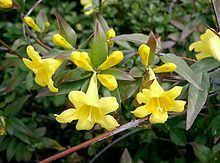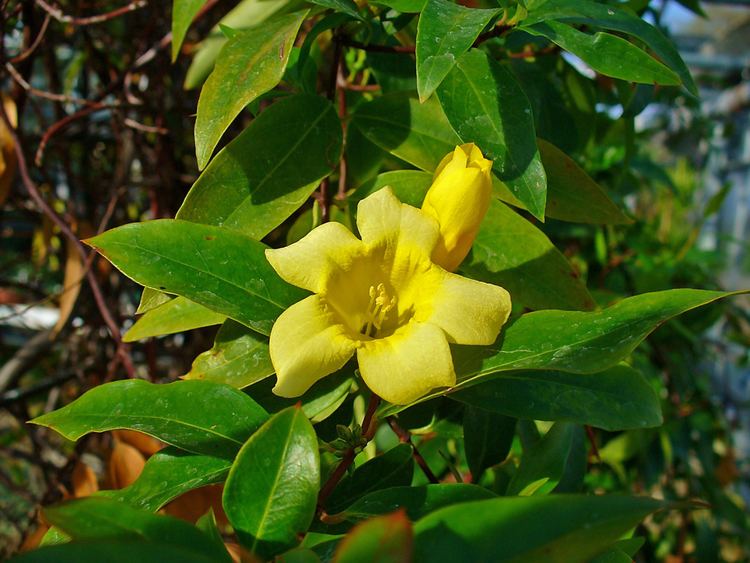Higher classification Gelsemium | Scientific name Gelsemium sempervirens Rank Species | |
 | ||
Similar Gelsemium, Strychnos ignatii, Strychnine tree, Bryonia, Aconitum napellus | ||
Gelsemium sempervirens carolina jessamine blooming at the crosby arboretum january 2012
Gelsemium sempervirens is a twining vine in the family Gelsemiaceae, native to subtropical and tropical America: Honduras, Guatemala, Belize, Mexico (Chiapas, Oaxaca, Veracruz, Puebla, Hidalgo), and southeastern and south-central United States (from Texas to Virginia). It has a number of common names including yellow jessamine or jasmine, Carolina jasmine or jessamine, evening trumpetflower, gelsemium and woodbine.
Contents
- Gelsemium sempervirens carolina jessamine blooming at the crosby arboretum january 2012
- Growth
- Medical use
- Toxicity
- References

Growth

Gelsemium sempervirens can grow to 3–6 m (9.8–19.7 ft) high when given suitable climbing support in trees, with thin stems. The leaves are evergreen, lanceolate, 5–10 cm (2.0–3.9 in) long and 1–1.5 cm (0.39–0.59 in) broad, and lustrous, dark green. The flowers are borne in clusters, the individual flowers yellow, sometimes with an orange center, trumpet-shaped, 3 cm (1.2 in) long and 2.5–3 cm (0.98–1.18 in) broad. Its flowers are strongly scented and produce nectar that attracts a range of pollinators.
Medical use

Historically Gelsemium sempervirens was used as a topical to treat papulous eruptions. It was also used to treat measles, neuralgic otalgia, tonsillitis, esophagitis, dysmenorrhea, muscular rheumatism, headaches.
Toxicity

All parts of this plant contain the toxic strychnine-related alkaloids gelsemine and gelseminine and should not be consumed. The sap may cause skin irritation in sensitive individuals. Children, mistaking this flower for honeysuckle, have been poisoned by sucking the nectar from the flower. The nectar is also toxic to honeybees, which may cause brood death when gathered by the bees. The nectar may, however, be beneficial to bumblebees. It has been shown that bees fed on gelsemine have a reduced load of Crithidia bombi in their fecal matter. Reduced parasite load increases foraging efficiency, and pollinators may selectively collect otherwise toxic secondary metabolites as a means of self-medication.

Despite the hazards, this is a popular garden plant in warmer areas, frequently being trained to grow over arbors or to cover walls.
Yellow Jessamine is the state flower of South Carolina.
